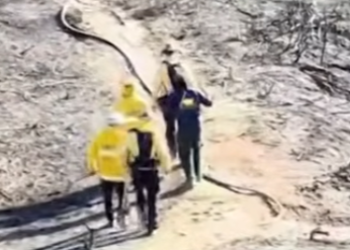
Dexter McCullough, Contributor at Misleading.com 10/14/25 3:15pm MST
It began with a single boot: the Danner Sharptail, designed for upland bird hunting. While combing through Danner’s PFAS-compliant product list, one detail stood out—the Sharptail was missing. That omission sparked a deeper investigation into the presence of PFAS across our outdoor gear: boots, gloves, rain jackets, and beyond. What started as a product check turned into a broader inquiry into chemical transparency in the gear we trust.
Boots, Gloves, and Rain Gear: The PFAS Trail Nobody’s Talking About
Introduction: PFAS in the Wild
PFAS—per- and polyfluoroalkyl substances—were once hailed as miracle compounds. Today, they’re a global environmental crisis. In 2025, California and New York banned PFAS in outdoor gear, triggering a wave of legislation across states like Montana. But the real story isn’t just about boots and jackets—it’s about how PFAS have infiltrated even the most remote ecosystems, including isolated glacier lakes.
These chemicals don’t degrade. They travel through air, water, and soil. And they’ve been found in precipitation over all five Great Lakes, in fish tissue from remote rivers, and in the sediment of alpine lakes once thought pristine.
Environmental Fallout: From Glacier Lakes to Groundwater
PFAS contamination is no longer confined to industrial zones. Studies show PFAS can be deposited via atmospheric transport, meaning they rain down on ecosystems far from their source. Glacier lakes—isolated, high-altitude bodies of water—have shown traces of PFAS, likely from airborne particles and precipitation. This means even untouched wilderness is no longer safe.
Once in the environment, PFAS leach into groundwater, rivers, and lakes. Wildlife absorb them through drinking water and food. In Michigan’s Clark’s Marsh, deer and fish tested positive for PFAS in their muscle tissue, prompting “Do Not Eat” advisories. These chemicals bioaccumulate, meaning they build up in organisms over time, disrupting endocrine systems, reproduction, and immune function.
Political Theater: Bans, Vetoes, and Loopholes
California’s initial push to ban PFAS in cookware and gear was met with fierce industry resistance. Governor Newsom vetoed SB 682, citing concerns over affordability and supply chain disruption. Critics argue this was a capitulation to corporate lobbying.
Montana, meanwhile, is drafting legislation that reflects its rugged outdoor ethos. Hunters and anglers are increasingly aware of PFAS risks—not from wearing boots, but from what those boots leave behind. Rain runoff from PFAS-treated gear can contaminate soil and water, especially in sensitive alpine environments.
Corporate Contortions: REI, Danner, and the GORE-TEX Gamble
REI led the charge, eliminating PFAS from its inventory. It wasn’t easy. Suppliers had to reformulate products, and performance suffered. Arc’teryx now uses PFAS-free GORE-TEX in its rain jackets, but admits the waterproofing doesn’t last as long.
Danner’s website lists some boots as “PFAS compliant,” meaning certain toxic compounds have been removed. But when I called about the Sharptail hunting boot, customer service confirmed it uses “improved GORE-TEX”—a vague term that likely means reduced PFAS, not eliminated.
Solomon and Alteryx, partial owners of the GORE-TEX brand, are navigating this transition carefully. GORE-TEX is a licensing powerhouse. Brands pay to use it and to advertise it. Consumers trust it. But that trust is now being tested.


The Manufacturing Menace: Waste, Water, and What We Leave Behind
The real danger isn’t wearing PFAS-treated gear—it’s making it. Manufacturing PFAS releases toxic waste into air and water. Wastewater treatment plants can’t fully remove PFAS, and biosolids used as fertilizer often carry contamination back into the soil.
Disposal is another problem. When PFAS-treated gear is thrown away, the chemicals persist in landfills, leaching into groundwater. Even rainwater dripping off a jacket can carry PFAS into streams. That’s why state bans matter—they target the full lifecycle of contamination.
Glacier Lakes as Warning Beacons
The detection of PFAS in glacier lakes is a red flag. These lakes are isolated, fed by snowmelt, and often considered benchmarks of environmental purity. Their contamination suggests that PFAS are now part of the global water cycle. They travel through clouds, fall with rain, and settle into ecosystems that have never seen a factory.
This challenges the notion that PFAS are a localized problem. They’re planetary. And they demand a planetary response.

As of September of 2025, a growing number of U.S. states are actively adopting or expanding climate-related policies, with many releasing formal plans and setting greenhouse gas (GHG) reduction targets. Several states have taken concrete steps toward implementing comprehensive climate action plans. Colorado, Hawaiʻi, Maine, Maryland, Nevada, and Wisconsin have released state-mandated climate strategies, while 45 states have published Priority Climate Action Plans (PCAPs). For 17 of those states, the PCAP represents their first formal climate roadmap, signaling a significant shift toward structured environmental policy.

In terms of emissions tracking, California, Connecticut, Colorado, Delaware, Hawai‘i, New Jersey, New Mexico, North Carolina, Pennsylvania, and Rhode Island have updated their GHG inventories, which are critical for measuring progress and refining future targets. Meanwhile, 24 states plus the District of Columbia have adopted specific GHG reduction targets, often paired with renewable energy goals and resilience strategies.
Grid modernization is another area gaining traction. Colorado, Delaware, Massachusetts, Minnesota, and New York have approved requirements to assess and upgrade their transmission and distribution systems. Additionally, ten Northeast states—including Connecticut, Maine, Maryland, Massachusetts, New Hampshire, New Jersey, New York, Rhode Island, and Vermont—signed a memorandum of understanding to improve interregional transmission planning.
States like California, Minnesota, and Virginia have also passed legislation requiring utilities to evaluate grid-enhancing technologies, indicating a broader commitment to infrastructure innovation. These developments suggest that while federal climate policy remains fragmented, state-level initiatives are accelerating, with many states not just adopting policies but actively shaping the future of clean energy and climate resilience.

Conclusion: Accountability in the Age of Forever Chemicals
PFAS are everywhere—from your frying pan to your hiking boots to the snowmelt in Montana’s alpine lakes. The bans in California and New York were a start. Montana’s draft legislation is a signal. But real change requires transparency, testing, and truth.
Dexter McCullough’s editorial mission is to expose the gaps. To ask why “PFAS compliant” isn’t “PFAS free.” To demand that brands like Danner, Arc’teryx, and Solomon own the full story—not just the marketing.
Because in the battle against forever chemicals, half-measures are just another form of misleading. We want to hear from YOU!





